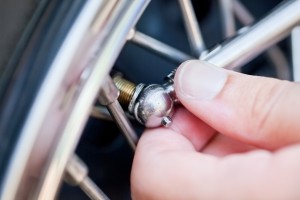Commuters in the Salt Lake City area have had more than their share of excitement this winter, whether it came in the form of mountainous snow, unsightly slush, or even freezing rain. Thankfully, the snow is no longer piling up higher than the average residence, the larger ice patches are beginning to give way to asphalt, and slush is melting into puddles. Now that the Spring Queen is shaking out the season’s first rays of sunshine from her skirts, the time has finally come for bicyclists to stop worrying about the risks of bicycle accident in the wintertime.
WRONG!—alas, as all of us know, the weather here can turn on a dime; and thanks to the temperature inversion, that dime doesn’t always sport the same face. Now is not the time to become complacent. Bicyclists in particular should always be observant of possible hazards, even those they have successfully surmounted throughout the winter season.
In short, Spring may be on its way, but we’re not out of the woods, yet! In the meantime, avoid bicycle accidents by refraining from end-of-season cockiness and remembering these principles:
1. Stay upright
Slippery conditions are no place to compromise your traction by leaning sideways far enough to skim an oily puddle with your finger. In fact, the best policy in snow and ice is to sit up straight, both because the contact of your tread with the road will be better assured that way and because doing so will lead you naturally to other behaviors conducive to wintertime safety (like making wide, easy turns). The precept is a simple one: If you want to remain upright…remain upright.
2. Use the back brake
Favoring the front brake, you run the risk of liquefying the surface you’re riding on and swerving into traffic, the shoulder, or an obliging snow bank. Riding the back brake, on the other hand, makes for easier control of the front of your bicycle in snow and ice…and, not inconsequentially, will allow you to stop more smoothly. To keep in contact with the road and avoid contact with a motor vehicle, shift your weight backward.
3. Forge a new path
Although more physically taxing, creating a new trail in the snow is safer than trying to stay upright while riding on snow that has been compacted by footprints, tires, or pedestrians. In addition, the snow flanking the bicycle tires will provide extra stability in case you hit an invisible rut and start to lose your balance. Bicycling through fresh snow may be exhausting, but it’s better than a bicycle accident (and great exercise!).
4. Watch for hidden hazards
While snow may resemble whipped marshmallow crème, it probably hides a few more rocks and twigs than your average banana split. Particularly in our rocky state, the road in front of the tires should be watched carefully for any bumps that appear out of place. A snowy/icy road is not a good place to be caught off guard.
 5. Lower your tire pressure
5. Lower your tire pressure
Letting enough air out of your tires that you have “visibly bulging contact patches” will lessen the impact of ruts and bumps and provide a wider contact area with the road. In patches where taut tires would be susceptible to veer or slide, low-pressure tires cling to the road and slide over the grooves that would otherwise deflect the tires. Easing up on the pressure in your tires relieves you of the pressure of hypervigilant steering.
While there is a great deal that bicyclists can do to prevent bicycle accidents, local businesses and the Utah Department of Transportation are also obligated to foster a safe commute. While they cannot control the elements, reasonable measures to lessen the risk of bicycling should be taken. If you have been seriously injured because an act of negligence—long-compacted snow buildup, invisible ice patches, etc.—that could have been prevented by standard responsibility has thwarted your best efforts, you may be eligible for compensation. When your bicycle accident paperwork becomes its own hassle, attorneys Christensen & Hymas can offer seasoned guidance and stellar representation. For more information, call (801) 506-0800.
